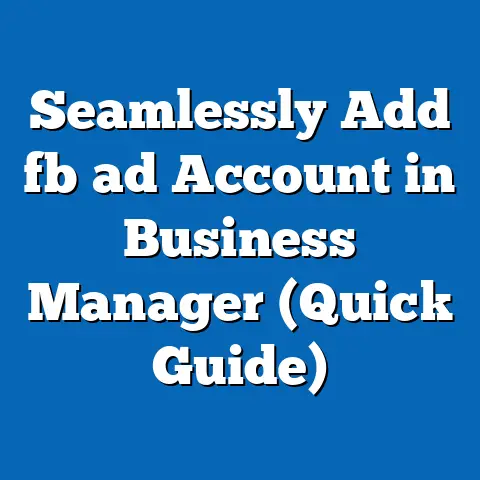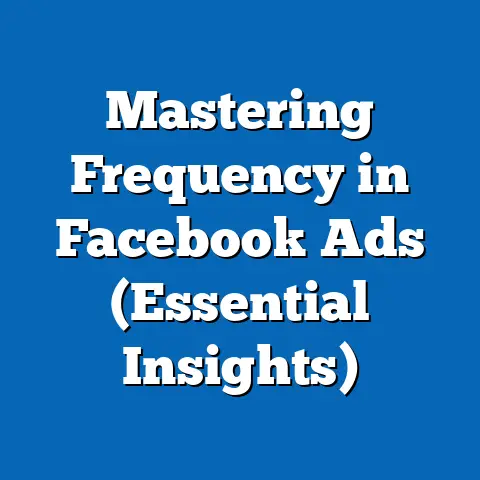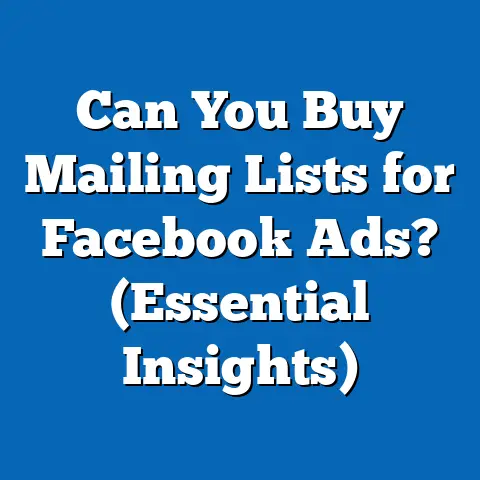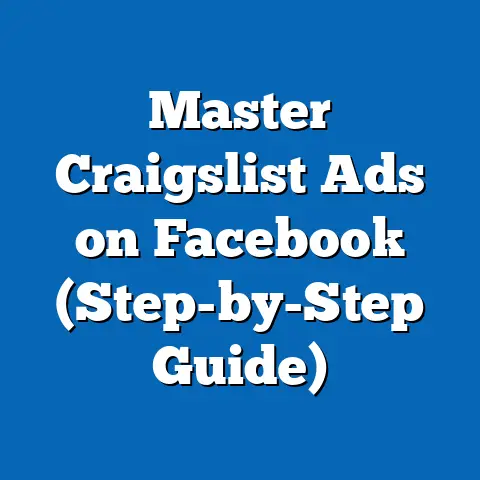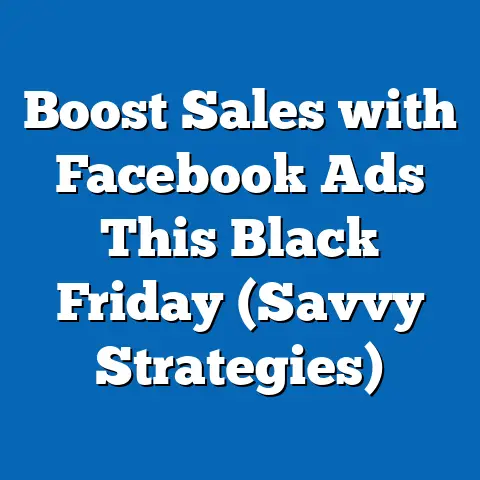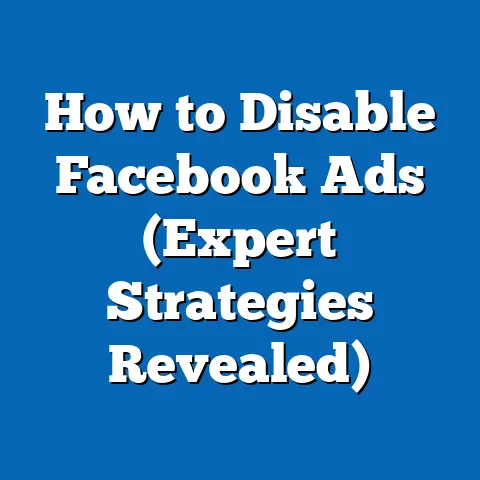Transform Brand Impact in Facebook Ads (Future Strategies)
First impressions matter. In the fast-paced world of digital marketing, especially on platforms like Facebook, that initial glimpse a potential customer has of your brand can make or break your success. Think about it: we’re bombarded with ads every single day. What makes one stand out from the noise? It’s that instantaneous connection, that spark of recognition or curiosity, that compels someone to stop scrolling and pay attention. We are not just selling products or services, we are selling experiences.
In the realm of online advertising, a “first impression” isn’t just a visual element; it’s a holistic experience. It encompasses the visual appeal of your ad, the clarity and relevance of your messaging, and the overall feeling your brand evokes. It’s about crafting an ad that not only grabs attention but also communicates value and resonates with your target audience on a personal level.
As we look to the future, the strategies for creating impactful first impressions on Facebook will need to evolve. Consumer behavior is becoming increasingly complex, influenced by a constant stream of information and ever-changing trends. To cut through the clutter, brands need to be more strategic, more creative, and more attuned to the needs and desires of their audience. This article is your guide to understanding how to transform your brand impact in Facebook ads, focusing on strategies that will resonate in the years to come.
I remember when I first started running Facebook ads, I thought it was all about flashy visuals and catchy slogans. I quickly learned that it’s so much more than that. It’s about understanding your audience, crafting a message that speaks to their needs, and creating an experience that leaves a lasting impression. It’s about building a connection, not just making a sale.
Understanding First Impressions in Facebook Ads
So, what exactly constitutes a “first impression” in the context of Facebook advertising? It’s more than just the initial visual – it’s a multifaceted experience that encompasses several key elements:
- Visual Appeal: This includes the images or videos used in your ad. Are they high-quality, relevant, and visually appealing? Do they immediately grab the viewer’s attention?
- Messaging Clarity: Is your message clear, concise, and easy to understand? Does it quickly communicate the value proposition of your product or service?
- Brand Presence: Does your ad reflect your brand’s personality and values? Is it consistent with your overall branding?
- Relevance: Does your ad resonate with the viewer’s interests and needs? Is it targeted to the right audience?
- Call to Action: Is your call to action clear and compelling? Does it encourage the viewer to take the desired action?
Statistics consistently highlight the critical role of first impressions in advertising. Studies show that it takes just a fraction of a second for people to form an opinion about a website or advertisement. In fact, research suggests that users form a subconscious judgment about a product within 90 seconds of initial viewing, and that 62%-90% of that assessment is based on color alone. This underscores the importance of visual elements and branding in creating a positive first impression.
However, many brands fall into common pitfalls when creating Facebook ads, leading to missed opportunities for impactful first impressions. Some of these pitfalls include:
- Poor Visual Quality: Using blurry, low-resolution images or videos can immediately turn viewers off.
- Confusing Messaging: Overly complex or jargon-filled messaging can confuse viewers and fail to communicate the value proposition effectively.
- Inconsistent Branding: Ads that don’t align with the overall brand identity can create a disjointed and confusing experience for viewers.
- Irrelevant Targeting: Showing ads to the wrong audience can lead to low engagement and wasted ad spend.
- Weak Call to Action: A vague or uninspired call to action can fail to motivate viewers to take the desired action.
Let’s look at some examples of successful Facebook ads that have made a significant impact upon first viewing. Consider the “Dollar Shave Club” ads. They were known for their humorous and quirky videos that immediately grabbed attention. Their success stemmed from:
- Unique Visuals: Their videos were unlike anything else on Facebook at the time, making them instantly memorable.
- Clear Messaging: They clearly communicated their value proposition – affordable razors delivered to your door.
- Brand Personality: Their ads perfectly reflected their brand’s irreverent and humorous personality.
Another great example is the “Always #LikeAGirl” campaign. This campaign challenged societal stereotypes about girls and women, resonating with viewers on an emotional level. The key elements of their success were:
- Emotional Connection: They tapped into a powerful emotional issue, creating a strong connection with viewers.
- Social Relevance: Their message was socially relevant and aligned with current cultural conversations.
- Authenticity: Their campaign felt genuine and authentic, resonating with viewers who were tired of overly polished and artificial advertising.
Takeaway: Understanding the key elements of a strong first impression and avoiding common pitfalls is crucial for creating Facebook ads that capture attention and resonate with your target audience. Focus on high-quality visuals, clear messaging, consistent branding, relevant targeting, and a compelling call to action.
The Evolution of Facebook Advertising
To truly understand the future of Facebook advertising and how to enhance brand impact, it’s important to take a look back at its evolution. Facebook advertising has come a long way since its early days, evolving from simple text-based ads to sophisticated, data-driven campaigns.
In the beginning, Facebook ads were relatively basic. Advertisers could target users based on limited demographic information, such as age, location, and interests. However, as Facebook’s user base grew and its technology advanced, advertising capabilities became increasingly sophisticated.
One of the biggest turning points in Facebook advertising was the introduction of AI and machine learning. These technologies allowed Facebook to analyze vast amounts of data and identify patterns in user behavior. This, in turn, enabled advertisers to target their ads with much greater precision, reaching the right people with the right message at the right time.
Another key evolution in Facebook advertising has been the rise of personalization. Consumers today expect personalized experiences, and they’re more likely to engage with ads that are relevant to their interests and needs. Facebook has responded to this trend by offering a range of personalization options, allowing advertisers to tailor their ads to individual users based on their demographics, interests, behaviors, and even past purchases.
Social proof has also become increasingly important in establishing a positive first impression. Consumers are more likely to trust recommendations from friends, family, and other users than they are to trust traditional advertising. That’s why user-generated content, such as reviews, testimonials, and photos, can be so powerful in building trust and credibility.
I remember when I first started using Facebook ads, I was amazed by the level of targeting that was available. I could target people based on their interests, their behaviors, and even their life events. It was like having a direct line to my ideal customer.
Takeaway: Facebook advertising has evolved dramatically over the years, driven by advancements in technology and changing consumer expectations. To stay ahead of the curve, brands need to embrace personalization, leverage social proof, and continuously adapt their strategies to the ever-changing landscape of Facebook advertising.
Future Strategies for Enhancing Brand Impact
Now that we’ve explored the importance of first impressions and the evolution of Facebook advertising, let’s dive into the future strategies that will help you transform your brand impact:
Leveraging Advanced Targeting Techniques
In the future, simply targeting broad demographics won’t cut it. You need to leverage advanced targeting techniques to reach the right audience with the right message. This includes:
- Audience Segmentation: Divide your audience into smaller, more specific segments based on their demographics, interests, behaviors, and purchase history. This allows you to create highly targeted ads that resonate with each segment.
- Lookalike Audiences: Use Facebook’s lookalike audience feature to find new customers who are similar to your existing customers. This is a great way to expand your reach and find people who are likely to be interested in your products or services.
- Custom Audiences: Create custom audiences based on your website traffic, email lists, and other data sources. This allows you to target people who have already interacted with your brand, increasing the likelihood of conversion.
- Behavioral Targeting: Target users based on their online behaviors, such as the websites they visit, the apps they use, and the purchases they make. This allows you to reach people who are actively interested in your products or services.
Data analytics plays a crucial role in understanding your audience better and tailoring your messaging accordingly. By analyzing data from your Facebook ads, website, and other sources, you can gain valuable insights into your audience’s demographics, interests, behaviors, and preferences. This information can then be used to create more effective ads that resonate with your target audience.
For example, if you’re selling a fitness product, you can use data analytics to identify the specific types of workouts your target audience is interested in, the fitness influencers they follow, and the fitness-related websites they visit. This information can then be used to create ads that feature relevant content and messaging, increasing the likelihood of engagement and conversion.
Creative Content and Visual Storytelling
In a world saturated with advertising, high-quality visuals and compelling narratives are essential for capturing attention and making a lasting impression.
- Video Ads: Video ads are becoming increasingly popular on Facebook, as they’re highly engaging and allow you to tell a more compelling story. Experiment with different video formats, such as short-form videos, live videos, and 360-degree videos.
- Interactive Posts: Interactive posts, such as quizzes, polls, and surveys, can be a great way to engage your audience and collect valuable data.
- Augmented Reality Experiences: Augmented reality (AR) experiences are becoming increasingly popular on Facebook, allowing users to interact with your products in a fun and engaging way. For example, you could create an AR filter that allows users to virtually try on your products.
- Personalized Visuals: Tailor your visuals to specific audience segments. Use images and videos that resonate with their demographics, interests, and cultural backgrounds.
Consider the example of a travel agency promoting a trip to Italy. Instead of using generic stock photos, they could create a video ad featuring real travelers sharing their experiences in Italy. The video could showcase the stunning scenery, the delicious food, and the vibrant culture of Italy, creating a sense of wanderlust and inspiring viewers to book their own trip.
Integrating User-Generated Content
User-generated content (UGC) is any content created by your customers, such as reviews, testimonials, photos, and videos. UGC is a powerful tool for building trust and credibility, as it provides social proof that your products or services are valuable and worthwhile.
- Run Contests and Giveaways: Encourage your customers to create and share content related to your brand by running contests and giveaways.
- Feature UGC on Your Facebook Page: Showcase your best UGC on your Facebook page to inspire other customers to create and share their own content.
- Use UGC in Your Facebook Ads: Incorporate UGC into your Facebook ads to make them more authentic and relatable.
One successful example of a campaign that utilized UGC effectively is GoPro’s “Photo of the Day” contest. GoPro encourages its customers to submit their best photos and videos taken with GoPro cameras, and the winner is featured on GoPro’s social media channels. This not only generates a ton of UGC but also showcases the versatility and quality of GoPro cameras.
Building Community and Engagement
Facebook is a social platform, so it’s important to foster community and interaction through your ads. This means creating ads that encourage users to comment, share, and engage with your brand.
- Ask Questions: Ask questions in your ads to encourage users to share their thoughts and opinions.
- Run Polls and Quizzes: Run polls and quizzes to engage your audience and collect valuable data.
- Respond to Comments and Messages: Respond to comments and messages promptly and professionally to show your audience that you care about their opinions.
- Create a Facebook Group: Create a Facebook group where your customers can connect with each other and share their experiences with your brand.
Consider the example of a clothing retailer that creates a Facebook ad asking users to share their favorite outfits featuring the retailer’s clothing. This not only encourages user engagement but also provides valuable insights into how customers are styling the retailer’s clothing.
Sustainability and Ethical Branding
In today’s world, consumers are increasingly concerned about sustainability and ethical practices. Brands that demonstrate a commitment to these values are more likely to resonate with modern consumers and create a positive first impression.
- Highlight Your Sustainability Efforts: If your brand is committed to sustainability, highlight your efforts in your Facebook ads.
- Partner with Ethical Organizations: Partner with ethical organizations to demonstrate your commitment to social responsibility.
- Use Sustainable Materials: If possible, use sustainable materials in your products and packaging.
- Support Local Communities: Support local communities through charitable donations and volunteer work.
For example, a coffee company that sources its beans from sustainable farms could highlight this in its Facebook ads. They could also partner with a local environmental organization to plant trees in the community. This would demonstrate their commitment to sustainability and resonate with consumers who are looking for ethically sourced products.
Takeaway: The future of Facebook advertising is about more than just targeting and optimization. It’s about creating meaningful connections with your audience, building trust and credibility, and demonstrating a commitment to social responsibility. By leveraging advanced targeting techniques, creating compelling content, integrating user-generated content, building community, and embracing sustainability, you can transform your brand impact on Facebook and achieve lasting success.
Case Studies of Successful Brand Transformations
Let’s take a look at some real-world examples of brands that have successfully transformed their impact through innovative Facebook ad strategies:
Case Study 1: Airbnb
Airbnb initially struggled to gain traction with its Facebook ads. Their ads were generic and didn’t resonate with their target audience. However, they transformed their approach by:
- Focusing on Visual Storytelling: They started using high-quality photos and videos of unique and inspiring Airbnb properties.
- Targeting Specific Interests: They targeted users based on their travel interests and preferences.
- Highlighting the Unique Experience: They emphasized the unique experience of staying in an Airbnb property, rather than just focusing on price.
As a result, Airbnb saw a significant increase in engagement and bookings. Their ads became more visually appealing, more relevant, and more persuasive.
Key Takeaway: Focus on visual storytelling and target specific interests to create ads that resonate with your target audience.
Case Study 2: Warby Parker
Warby Parker disrupted the eyewear industry with its affordable and stylish glasses. They used Facebook ads to:
- Showcase Their Unique Brand Personality: Their ads were quirky, humorous, and relatable.
- Offer a Home Try-On Program: They offered a home try-on program, allowing customers to try on five pairs of glasses for free before making a purchase.
- Highlight Their Social Mission: They highlighted their “Buy a Pair, Give a Pair” program, which donates a pair of glasses to someone in need for every pair purchased.
Warby Parker’s Facebook ads were highly successful in driving traffic to their website and increasing sales. Their ads were memorable, persuasive, and aligned with their brand values.
Key Takeaway: Showcase your unique brand personality and offer a compelling incentive to encourage customers to try your products.
Case Study 3: Dove
Dove is known for its “Real Beauty” campaign, which challenges societal stereotypes about beauty. They used Facebook ads to:
- Promote Their Message of Self-Acceptance: Their ads featured real women of all shapes, sizes, and ethnicities.
- Spark Conversations: Their ads sparked conversations about beauty standards and self-esteem.
- Build a Community: They built a community of women who support each other and celebrate their unique beauty.
Dove’s Facebook ads were highly successful in building brand awareness and loyalty. Their ads were emotionally resonant, socially relevant, and aligned with their brand values.
Key Takeaway: Promote a message that resonates with your target audience and build a community around your brand.
Case Study 4: Old Spice
Old Spice revitalized its brand with a humorous and irreverent campaign featuring “The Man Your Man Could Smell Like.” They used Facebook ads to:
- Create a Viral Sensation: Their ads were highly shareable and generated a ton of buzz.
- Engage with Fans: They engaged with fans on Facebook by responding to comments and creating personalized videos.
- Reach a New Audience: They reached a new audience of younger men who were previously uninterested in Old Spice.
Old Spice’s Facebook ads were highly successful in increasing brand awareness and sales. Their ads were funny, memorable, and unexpected.
Key Takeaway: Create ads that are shareable and engaging, and don’t be afraid to take risks.
Takeaway: These case studies demonstrate that successful brand transformations on Facebook require a combination of creativity, strategy, and a deep understanding of your target audience. By focusing on visual storytelling, showcasing your unique brand personality, promoting a message that resonates with your audience, and creating ads that are shareable and engaging, you can transform your brand impact on Facebook and achieve lasting success.
Conclusion
As we’ve explored throughout this article, first impressions are paramount in the world of Facebook advertising. In a landscape saturated with content and vying for attention, making that initial impact can determine whether your brand resonates with potential customers or fades into the background.
The future of Facebook advertising lies in a strategic blend of advanced targeting techniques, creative content, user-generated content integration, community building, and a commitment to sustainability and ethical branding. By embracing these strategies, brands can transcend the limitations of traditional advertising and forge meaningful connections with their audience.
Looking ahead, the key is adaptability and continuous innovation. The digital landscape is constantly evolving, and brands must remain agile and responsive to the changing needs and preferences of consumers. By staying informed, experimenting with new approaches, and leveraging the power of data, brands can unlock the full potential of Facebook advertising and transform their impact on the platform.
In closing, remember that Facebook advertising is not just about selling products or services; it’s about telling stories, building relationships, and creating experiences that resonate with your audience. By focusing on these elements, you can transform your brand impact on Facebook and achieve lasting success in the years to come. The power to transform your brand impact on Facebook is within your reach. Embrace the future, and let your brand shine.

